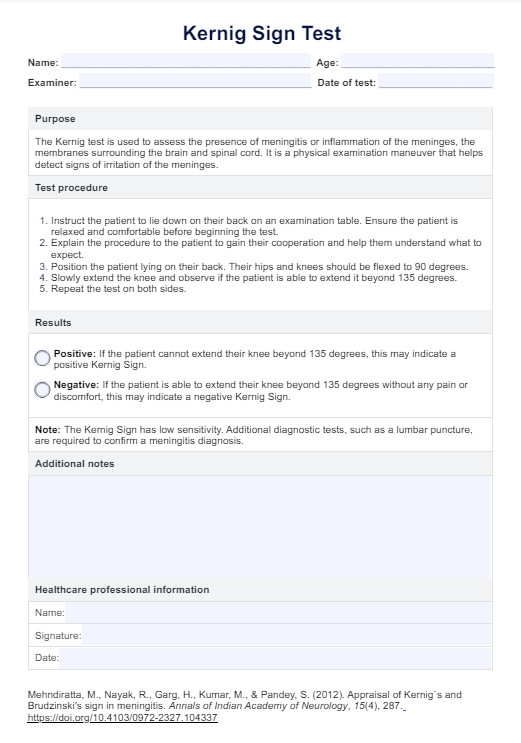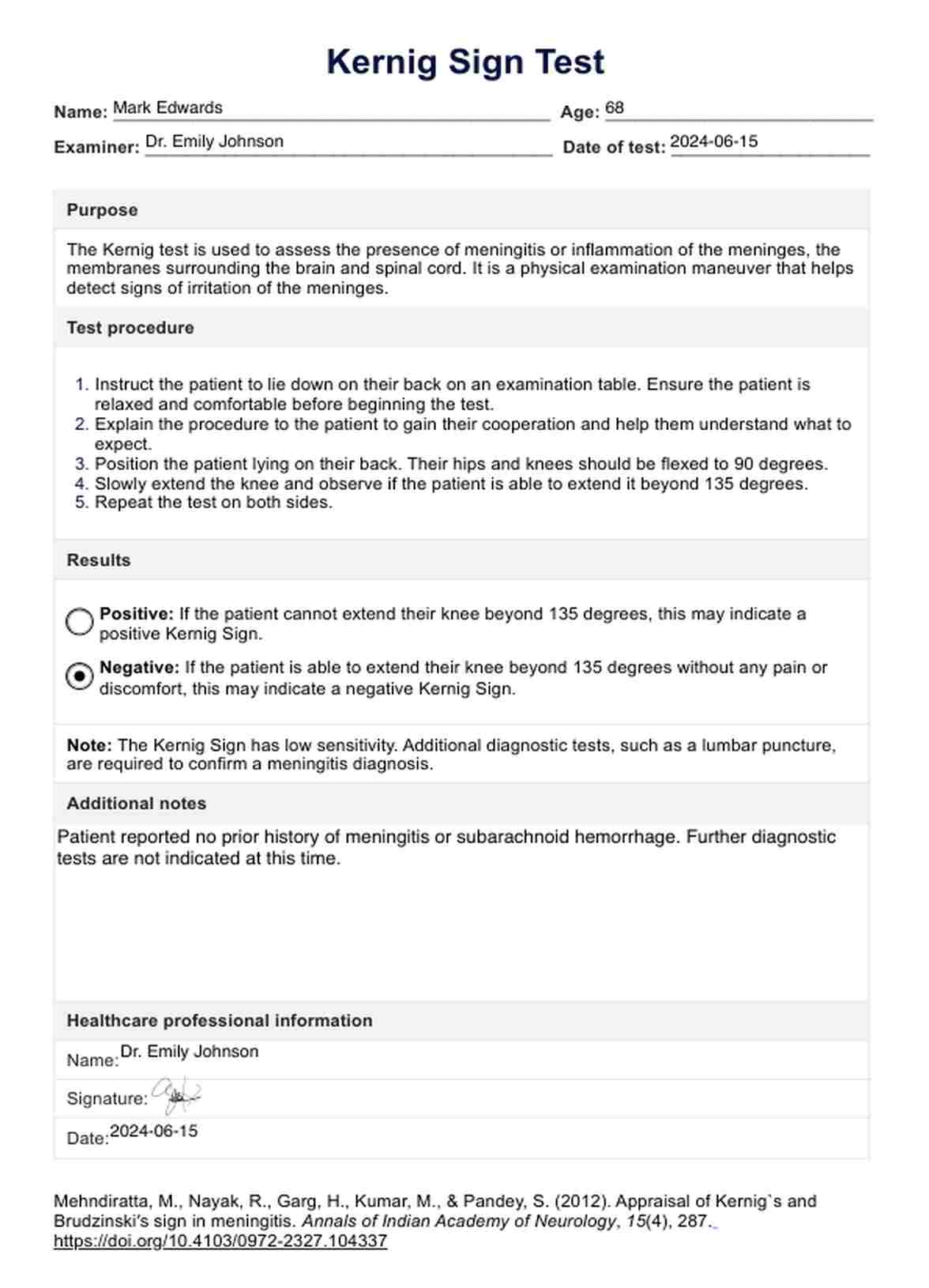Kernig Sign Test
Learn about the Kernig Sign Test for detecting meningeal irritation, its benefits, and treatments for meningitis. Download our free template for healthcare professionals.


What is meningitis?
Meningitis is a serious medical condition that refers to the inflammation of the protective membranes surrounding the brain and spinal cord. These membranes are known as the meninges, hence the name meningitis.
The inflammation of the meninges is usually caused by an infection, most commonly bacterial or viral. In some cases, it can also be caused by fungal infections or non-infectious causes such as certain medications or autoimmune disorders.
Meningitis can spread through different means depending on the type of infection causing it. Bacterial meningitis can spread through respiratory droplets when an infected person coughs or sneezes, while viral meningitis can spread through contact with contaminated bodily fluids.
Meningitis symptoms
Symptoms of meningitis can develop suddenly and may include:
- Severe headache
- Stiff neck
- High fever
- Sensitivity to light (photophobia)
- Nausea and vomiting
- Confusion or difficulty concentrating
- Seizures
In some cases, more severe symptoms, such as confusion and seizures, may raise suspicion of the condition and require further diagnostic testing.
Causes of meningitis
The primary causes of meningitis include:
- Bacterial infections: Streptococcus pneumoniae, Neisseria meningitidis, and Haemophilus influenzae.
- Viral infections: Enteroviruses, herpes simplex virus, and mumps virus.
- Fungal infections: Cryptococcus and Histoplasma.
Potential problems meningitis may cause
If not treated promptly, meningitis can lead to serious complications, such severe symptoms such as:
- Brain damage
- Hearing loss
- Learning disabilities
- Seizures
- Hydrocephalus (fluid buildup in the brain)
- Death
Kernig Sign Test Template
Kernig Sign Test Example
What is the Kernig Sign Test?
The Kernig Sign Test is a clinical examination used to detect irritation of the meninges, the protective membranes covering the brain and spinal cord. This test is beneficial for identifying conditions such as meningitis or subarachnoid hemorrhage, which can cause significant neurological complications if not promptly diagnosed and treated.
To perform the Kernig Sign Test, the examiner positions the patient lying on their back with the hips and knees flexed to 90 degrees. The examiner then slowly extends the patient's knee.
A positive Kernig's sign is indicated if the patient cannot extend beyond 135 degrees , due to pain and stiffness in the hamstring muscles (Mehndiratta et al., 2012) This is an indication of irritation or inflammation of the meninges, as a result of increased pressure within the skull. However, it is important to note that a positive Kernig's sign can also be caused by other conditions such as arthritis or muscle strains.
To accurately interpret the results of the Kernig Sign Test, healthcare professionals must consider other clinical findings and perform further diagnostic tests if necessary. In addition to this test, other physical exams such as Brudzinski's sign and lumbar puncture may be performed to confirm a diagnosis.
How to use our Kernig Sign Test template
The Kernig Sign Test template is designed to streamline the process for healthcare professionals in detecting meningeal irritation in patients. Follow these simple steps to ensure accurate and efficient testing.
Step 1: Prepare the template
Download and print the Kernig Sign Test template. Ensure all sections, including patient information and results, are ready for recording data. Have any necessary equipment, such as a comfortable examination table, prepared in advance.
Step 2: Document patient information
Fill out the patient information section at the top of the template. Accurate documentation is crucial for maintaining detailed medical records.
Step 3: Perform the test
Prepare the patient by explaining the test and ensuring they are comfortable. Then, follow the instructions in the test procedure section.
Step 4: Record the results
Use the template to document your findings. Make sure to note any abnormalities or concerns. This will help you track the progress of your patient and provide comprehensive care.
Step 5: Evaluate and conclude
Based on the individual leg results, determine the diagnostic value for the overall result and mark it accordingly. Provide additional notes if necessary, and ensure the healthcare professional's information is completed, including their name, signature, and date.
Treatments for meningitis
Treating meningitis involves managing symptoms, eradicating the infection, and preventing complications. The specific treatment approach depends on the type of meningitis, whether bacterial, viral, or fungal.
Antimicrobial therapy
For bacterial meningitis, immediate antibiotic treatment is crucial. The choice of antibiotics depends on the type of bacteria causing the infection, the patient's age, and health status. Commonly used antibiotics include ceftriaxone, vancomycin, and ampicillin. In some cases, corticosteroids like dexamethasone are also administered to reduce inflammation and prevent complications such as hearing loss.
Antiviral medications
Viral meningitis typically requires supportive care, as it is often less severe and self-limiting. However, in cases caused by herpesvirus or influenza, antiviral medications such as acyclovir or oseltamivir may be prescribed to reduce the severity and duration of symptoms.
Antifungal treatment
For fungal meningitis, antifungal medications like amphotericin B or fluconazole are used. Treatment duration may be prolonged; hospitalization is often required to manage the infection effectively.
Supportive care
Supportive care is essential for all types of meningitis. This includes maintaining hydration, managing fever, and providing pain relief. Hospitalization may be necessary to monitor and treat complications such as seizures, brain swelling, and shock.
Preventive measures for suspected bacterial meningitis
Preventing meningitis involves vaccination, particularly for the suspected bacterial meningitis types. Vaccines such as meningococcal, pneumococcal, and Haemophilus influenzae type b (Hib) effectively reduce meningitis incidence. Prophylactic antibiotics may also be given to close contacts of individuals with bacterial meningitis to prevent the spread of infection.
Post-treatment care
After acute treatment, rehabilitation may be necessary for patients who have experienced complications. This can include physical, occupational, and speech therapy to help regain lost functions and improve quality of life.
Reference
Mehndiratta, M., Nayak, R., Garg, H., Kumar, M., & Pandey, S. (2012). Appraisal of Kernig`s and Brudzinski′s sign in meningitis. Annals of Indian Academy of Neurology, 15(4), 287. https://doi.org/10.4103/0972-2327.104337
Commonly asked questions
Diagnosing meningitis typically involves a combination of clinical signs and medical tests. Clinicians look for symptoms such as a severe headache, stiff neck, fever, confusion, and sensitivity to light. Kernig and Brudzinski's signs are also commonly used to help diagnose meningitis. In addition, a lumbar puncture (spinal tap) may be performed to collect cerebrospinal fluid for testing.
A positive Kernig sign is indicated when a patient is unable to extend their knees beyond 135 degrees. This suggests meningeal irritation.
The Kernig Sign Test alone cannot diagnose meningitis. It is a clinical sign that suggests meningeal irritation, warranting further diagnostic testing such as lumbar puncture and imaging to confirm meningitis.







































































































